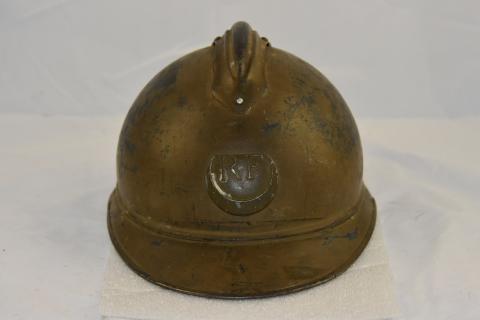This is a French M15 Adrian-style helmet, produced during the early years of the First World War. It consists of a dome with a pinched ridge along the top axis and a rim which flares out from the bottom in an elliptical shape. This item has sustained some wear along its outer surface, where its olive-green coloration has faded or been scratched. The interior of the helmet is well preserved and maintains its leather/cloth lining. An insignia of a crescent framing the letters "R.F" adorns the forward-facing exterior surface of the helmet. This insignia denotes that the soldier who wore the helmet served in North Africa during World War I, particularly in Senegal, which was at that point in time a French colony. The French Empire had conquered Senegal in the 17th century; the country only became independent in 1958. The M15 Adrian helmet is notable for being the first steel helmet widely used in modern warfare. At the outbreak of World War I, French commanders noted that the traditional French military cap, the Kapi, provided no protection against overhead shrapnel or concussions. Thus, they devised the Adrian with a ridge meant to both protect soldiers' heads and disperse shrapnel which exploded in the air above them. Use of the Adrian greatly reduced the amount of head injuries and fatalities that occurred on the front lines, prompting other European powers to adopt similar designs for their own steel helmets. This content can be used with the following resources: SS.4.25: Technological Change This content can be used to educate students on the evolution of military protective technology during the first half of the twentieth century and how it affected the service of Iowans in the armed forces. For any use other than instructional resources, please check with the organization that owns this item for any copyright restrictions.
2018.002.018 [Helmet, Military]
Legal Status
Copyright to this resource is held by the Iowa Masonic Library and Museum and has been provided here for educational purposes only, specifically for use in the Iowa Museum Association's "Teaching Iowa History" project. It may not be downloaded, reproduced or distributed in any format without written permission from the Rights Holder. For more information on U.S. and International copyright laws, consult an attorney.

